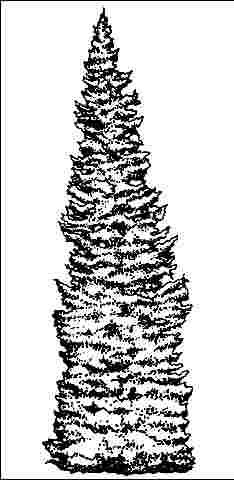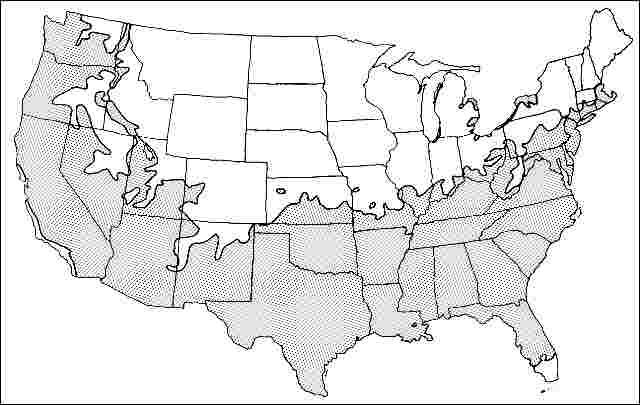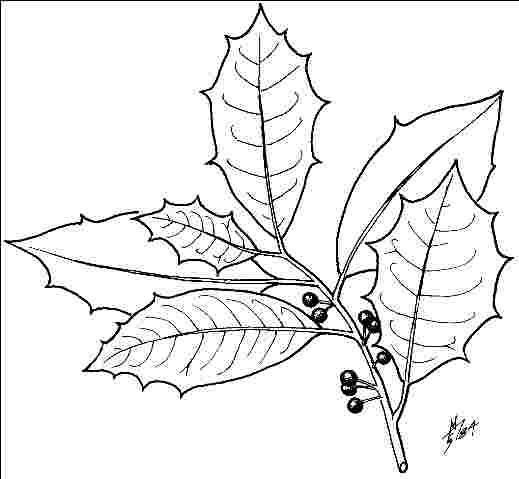Introduction
A popular landscape plant since the beginning of American history, this broad-leafed evergreen has served a variety of uses through the years. The American Indians used preserved holly berries as decorative buttons, which were much sought after by other tribes who bartered for them. The wood has been used for making canes, scroll work and furniture, and has even been substituted for ebony in inlay work when stained black.

General Information
Scientific name: Ilex opaca
Pronunciation: EYE-lecks oh-PAY-kuh
Common name(s): 'Slim Jim' American holly
Family: Aquifoliaceae
USDA hardiness zones: 6A through 9B (Figure 2)
Origin: native to North America
Invasive potential: native cultivar
Uses: street without sidewalk; screen; hedge; specimen; reclamation; sidewalk cutout (tree pit); urban tolerant; highway median; Bonsai

Description
Height: 30 to 50 feet
Spread: 10 to 15 feet
Crown uniformity: symmetrical
Crown shape: pyramidal, columnar
Crown density: dense
Growth rate: slow
Texture: medium
Foliage
Leaf arrangement: alternate (Figure 3)
Leaf type: simple
Leaf margin: pectinate, entire, spiny
Leaf shape: elliptic (oval), lanceolate
Leaf venation: pinnate, brachidodrome
Leaf type and persistence: evergreen, broadleaf evergreen
Leaf blade length: less than 2 inches, 2 to 4 inches
Leaf color: green
Fall color: no color change
Fall characteristic: not showy

Flower
Flower color: green, white/cream/gray
Flower characteristics: not showy
Fruit
Fruit shape: round
Fruit length: less than 0.5 inch
Fruit covering: fleshy
Fruit color: red
Fruit characteristics: attracts birds; showy; fruit/leaves not a litter problem
Trunk and Branches
Trunk/bark/branches: branches droop; not showy; typically one trunk; thorns
Pruning requirement: little required
Breakage: resistant
Current year twig color: green, brown
Current year twig thickness: medium
Wood specific gravity: 0.61
Culture
Light requirement: full sun, partial sun or partial shade, shade tolerant
Soil tolerances: sand; loam; clay; acidic; slightly alkaline; well-drained; occasionally wet
Drought tolerance: high
Aerosol salt tolerance: high
Other
Roots: not a problem
Winter interest: yes
Outstanding tree: no
Ozone sensitivity: unknown
Verticillium wilt susceptibility: resistant
Pest resistance: resistant to pests/diseases
Use and Management
This cultivar of American holly is a beautifully shaped tree, with a symmetrical, dense, narrow pyramidal form. The spiny, dull green leaves are accented with clusters of red berries which persist throughout the fall and winter. Male and female flowers appear on separate trees and trees of both sexes must be located in the same neighborhood to ensure production of berries on the female plants. American holly is ideal for use as a street tree (with lower branches removed), framing tree, specimen, barrier planting or screen. Roots are shallow and finely branched, and rarely invasive due to their great number and relatively small diameter. This native tree is ideal for naturalizing on moist, slightly acid soils, and the fruit is very attractive to wildlife, serving as an excellent food source. A 35-foot-tall tree can be 20-feet wide in 40 years.
Growing well in full sun to partial shade, American holly should be located on fertile, well-drained but moist, slightly acid soils below 6.5 pH. Berry production is highest in full sun on female trees. American holly foliage thins during drought, but insect and disease infestations are usually minimal.
See the species for other cultivars.
Propagation is by cuttings or grafting.
Pests
Holly leaf miner larvae mines out the leaf middle leaving yellow or brown trails.
Scales of various types may infest holly.
Spider mites cause discoloration and speckling of holly foliage.
Diseases
Tar spot may occasionally cause small yellow spots on the leaves in early summer. Eventually the spots turn reddish brown with narrow yellow borders. Leaves may not drop prematurely but the infected areas drop out leaving holes in the leaves. Gather up and destroy badly infected leaves.
Many different fungi cause leaf spots on holly. Reduce the injury caused by leaf spots by keeping trees healthy. Dispose of diseased leaves.
Cankers caused by several different fungi lead to sunken areas on stems and plant dieback. Keep trees healthy and prune out infected branches.
Spine spot is small gray or yellow spots with purple margins and is caused by spines of one leaf puncturing an adjacent leaf.
Chlorosis symptoms are light green or yellowish leaves with darker green veins. This problem is often due to a high pH leading to iron deficiency. Use acidifying fertilizers and sulfur to bring down the pH. Sprays of iron chelate will green up plants.
In northern climates, hollies sometimes scorch during the late winter due to rapid and wide temperature fluctuations. Shade plants during the winter to prevent the problem.
Purple blotches on the leaves are caused by some environmental factor such as nutrient deficiencies, drought, and winter injury.
Black root rot can be damaging.